Storage Refrigeration Monitoring Market Summary, 2032
The global storage refrigeration monitoring market was valued at $8.3 billion in 2022, and is projected to reach $17.6 billion by 2032, growing at a CAGR of 8% from 2023 to 2032. Storage refrigeration monitoring market overview refers to the process of actively monitoring and controlling the temperature and conditions of refrigerated storage spaces, such as cold rooms, walk-in freezers, or refrigerated warehouses.
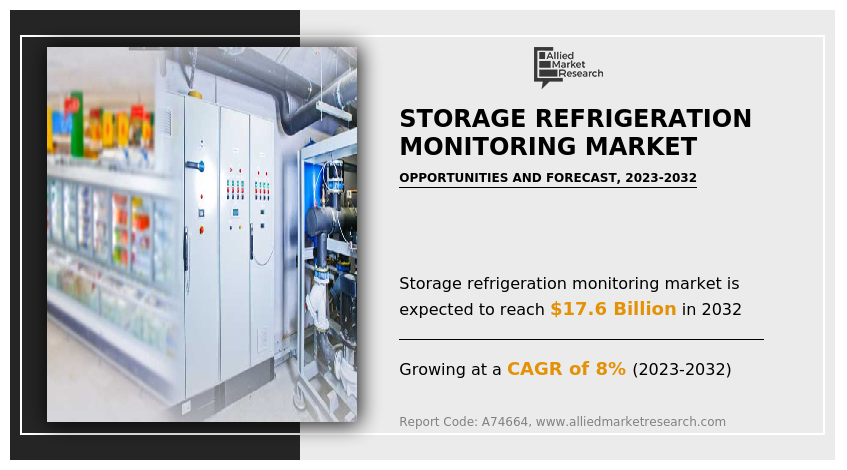
It involves the use of specialized equipment, sensors, and software systems to ensure that perishable goods, such as food, pharmaceuticals, or different temperature-sensitive products, are stored in optimal conditions to maintain their quality, safety, and shelf life.
The main purpose of storage refrigeration monitoring is to maintain the desired temperature range within the storage space. Refrigeration systems play an imperative role in preserving the freshness and integrity of perishable gadgets by controlling the temperature, humidity, and airflow.
Increasing consumer awareness about food safety and quality is indeed a significant driver for the growth of the storage refrigeration monitoring industry. Consumers are becoming more aware of the potential risks associated with improper food storage, such as bacterial growth, spoilage, and contamination. Consumer want to ensure that the food they consume maintains its freshness, nutritional value, and taste for as long as possible. This increased awareness has led to a rise in the demand for products and technologies that help in preserving food quality and extending shelf life.. Therefore, they expect food manufacturers, distributors, and retailers to implement measures to ensure proper storage conditions.
Food organizations recognize the importance of maintaining a strong brand reputation. By imposing storage refrigeration monitoring systems, companies can demonstrate their commitment to maintaining product quality, safety, and freshness, thereby enhancing consumer trust. Government regulations and food safety standards play an essential role in driving the adoption of storage refrigeration monitoring systems.
Many countries have established stringent regulations regarding temperature control and monitoring in food storage facilities. By implementing these systems, businesses can make certain compliance with the regulations and avoid penalties or legal consequences.
Consumer awareness about food protection continues to grow, and the adoption of storage refrigeration monitoring systems becomes crucial for food manufacturers, distributors, and retailers to meet purchaser expectations, maintain brand reputation, comply with regulations, ensure transparency, and make informed business decisions.
The lack of standardized protocols in the storage refrigeration monitoring market can act as a major restraining factor. The absence of universal standards or protocols can result in compatibility issues between different monitoring systems. Each machine may use its proprietary formats and protocols, making it difficult to integrate or exchange data seamlessly. This can create obstacles when organizations try to undertake comprehensive monitoring solutions involving multiple systems or when they want to collaborate with different stakeholders.
Inconsistent data codecs and communication protocols hinder interoperability, which refers to the ability of different structures to work collectively effectively. Without standardized protocols, integrating storage refrigeration monitoring systems with other infrastructure or software becomes complex. This lack of interoperability restricts the seamless flow of data, limiting the ability to create unified monitoring systems or centralized control systems. The absence of standardized protocols also impacts data collection and storage.
Different monitoring structures may also collect and keep information in various formats and structures, making it difficult to consolidate and analyze information across different systems or locations. This variability in data collection and storage methods hampers the capacity to derive significant insights or implement uniform analysis processes. These factors are anticipated to hamper the storage refrigeration monitoring market share in the upcoming years.
The rising focus on energy efficiency in the context of cold storage facilities presents significant opportunities for the storage refrigeration monitoring market. The high energy consumption of refrigeration systems in these facilities has led groups to prioritize energy-efficient options to decrease costs and reduce their environmental footprint. Therefore, storage refrigeration monitoring solutions that offer insights into energy usage and optimization have become more valuable.
By implementing monitoring systems, companies can gather data on energy consumption patterns, become aware of areas of inefficiency, and make informed decisions to optimize their refrigeration systems. These solutions can provide real-time information on temperature, humidity, and energy consumption, permitting companies to become aware of differences and take proactive measures to improve energy efficiency.
By leveraging advanced analytics and machine learning algorithms, businesses can optimize their cooling processes, reduce equipment downtime, and extend the lifespan of their refrigeration systems, which is predicted to generate excellent storage refrigeration monitoring market opportunity.
The key players profiled in this report include Emerson Electric Co., Johnson Controls, MAYEKAWA MFG. CO., LTD, United Technologies, Sensitech Inc., DAIKIN INDUSTRIES, Ltd, EVAPCO, Inc., GEA Group Aktiengesellschaft, Ingersoll Rand, and LU-VE S.p.A.
Investment and agreement are common strategies followed by major market players. For instance, in December 2021, Budderfly partnered with KE2 Therm Solutions. Commercial refrigeration machines can upload operational data to Budderfly's dashboard to be monitored, assure peak performance, and prevent failure owing to the integration of KE2 Therm refrigeration controllers and Budderfly's EnergyCloud learning algorithms.
The storage refrigeration monitoring market is segmented on the basis of system type, component, storage application, end-use industry, and region. By system type, the market is divided into software, hardware, and services.
By component, the market is classified into condenser, compressor, evaporator, expansion valve, and others. By storage application, the market is classified into fresh fruits & vegetables, beverages, dairy & ice cream, meat, medical & pharmaceutical products, and others.
By end-use industry, the market is classified into food & beverages, chemical & pharmaceuticals, healthcare, residential, and others. By region, the market is analyzed across North America, Europe, Asia-Pacific, and LAMEA. 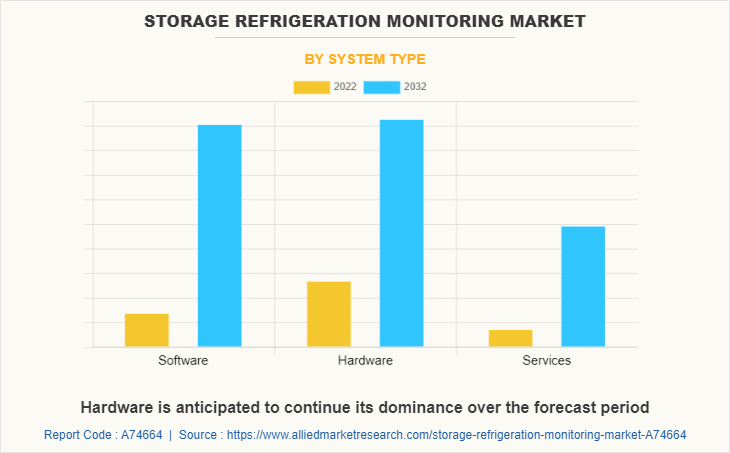
By system type, the hardware sub-segment dominated the market in 2022, due to the key role of hardware components in controlling and monitoring refrigeration systems in transportation units. Hardware systems include RFID devices, temperature and pressure sensors, networking devices, and others, that effectively check the temperature of the storage refrigeration systems.
Hardware is a key component in refrigeration monitoring units, and it includes temperature sensors, pressure sensors, touch sensors, defrost sensors, and liquid level sensors, as well as networking devices that monitor and control the refrigeration system and notify the user via alarms or notifications.
The use of refrigeration monitoring systems in cold storage and transportation systems to preserve perishable products is increasing the demand for hardware. These are predicted to be the major factors affecting the storage refrigeration monitoring market forecast period.
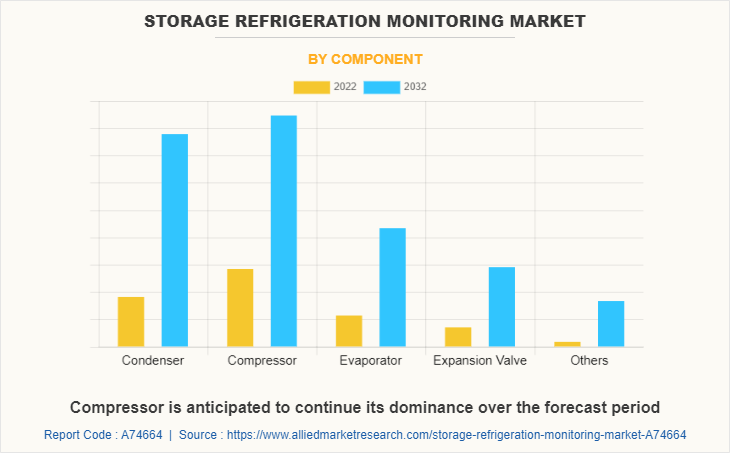
By component, the compressor sub-segment dominated the global storage refrigeration software market share in 2022. Compressors are frequently used in air conditioning units in both industrial and household refrigeration network applications such as humidifiers, chillers, and others. A compressor is a mechanical device that reduces the volume of a gas in order to increase its pressure.
Furthermore, the compressor is a key component in refrigeration systems that takes heat from the inside of the refrigerator and cools it with refrigerants. These aforementioned reasons are expected to boost compressor demand in the refrigeration system, consequently driving the storage refrigeration monitoring market size.
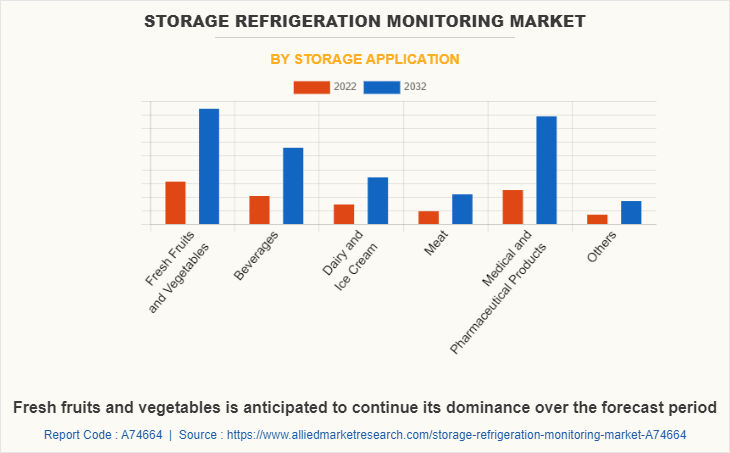
By storage application, the fresh fruits & vegetables sub-segment dominated the global storage refrigeration monitoring market in 2022, owing to high utilization of refrigeration systems for fresh fruits & vegetables storage since they require chilling temperature for their maintenance process. Moreover, the extensive usage of refrigeration systems by several food processing industries is also expected to drive the segment growth.
In addition, the popularity of refrigerated systems for storing fruits and vegetables demand a constant temperature during chilling and maintenance processes. The majority of food processing businesses prepare fruits and vegetables using freezing technologies, which is anticipated to boost the storage refrigeration monitoring market growth expansion during the forecast period.
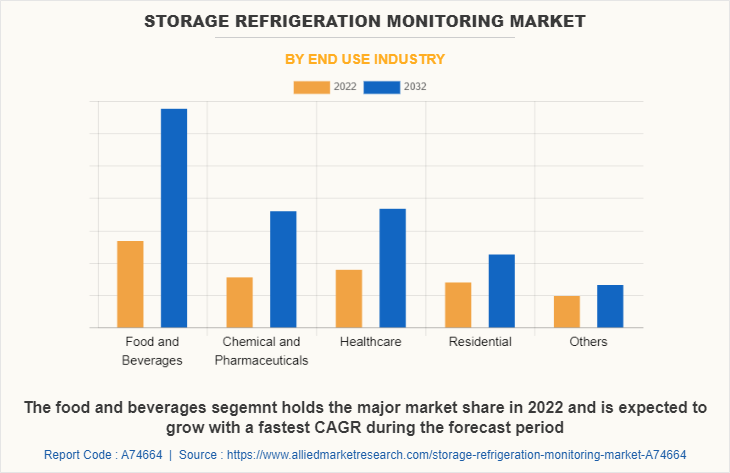
By end-use industry, the food & beverages sub-segment dominated the global storage refrigeration monitoring market in 2022. Consumers' taste for quality processed foods has shifted as a consequence of dietary changes and improved living standards, which has further boosted the need of cold chain monitoring systems in the food and beverage sectors, as processed goods require temperature-controlled storage facilities.
The rising desire to reduce food waste is driving demand for cold chain monitoring systems in the food & beverage sector. The demand for cold chain monitoring systems in the food & beverage industry is experiencing significant growth due to the increasing focus on extending food shelf life and reducing spoilage and contamination.
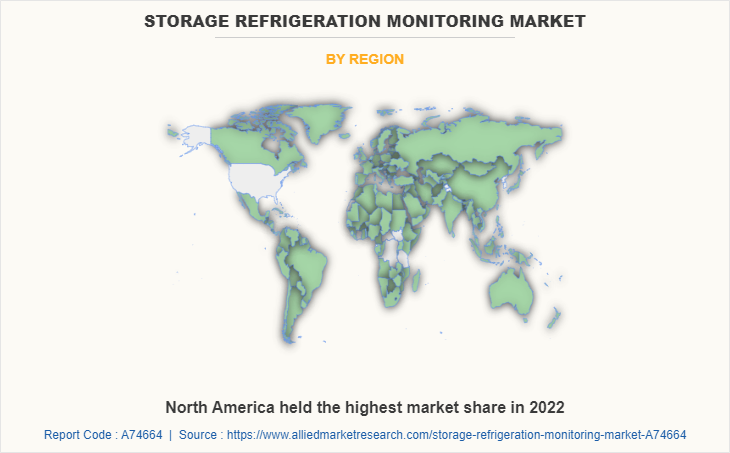
By region, North America dominated the global market in 2022. Advances in transportation and storage networks are projected to promote cold chain facility expansion and increase need for monitoring systems. Government expenditures in developing more efficient and innovative cold chain tracking and monitoring systems to promote supply chain productivity and efficiency are expected to drive market expansion in the region.
Rising customer demand for canned and processed foods in the region has resulted in increased use of cold chain monitoring technologies in the food & beverage sector. Pharmaceutical firms in the region are rapidly using cold chain monitoring technologies in order to manufacture and sell biologically based and cold-reliant medications. Government measures to eliminate public health concerns caused by inefficient medications are driving the implementation of more effective remote mobility solutions.
Impact of COVID-19 on the Global Storage Refrigeration Monitoring Industry
The COVID-19 pandemic has had a significant impact on various industries, including the storage refrigeration monitoring market. With the disruption in supply chains and increased focus on food safety and security during the pandemic, there has been a higher demand for storage refrigeration solutions. Many businesses involved in perishable goods, pharmaceuticals, and vaccines required effective monitoring systems to ensure proper storage conditions and prevent spoilage or wastage.
To minimize human contact and adhere to social distancing guidelines, there has been a rising trend towards remote monitoring and automation in storage refrigeration systems. Companies pursued advanced monitoring solutions that can be accessed and controlled remotely, allowing them to monitor temperatures, humidity levels, and other critical parameters without physically being present on-site.
The pandemic accelerated the adoption of Internet of Things (IoT) and cloud-based technologies in the storage refrigeration monitoring market. These technologies enable real-time data collection, analysis, and remote access to monitoring systems. IoT-enabled sensors and devices can provide valuable insights into temperature fluctuations, energy consumption, and equipment performance, facilitating proactive maintenance and reducing the risk of failures.
Key Benefits For Stakeholders
This report provides a quantitative analysis of the market segments, current trends, estimations, and dynamics of the storage refrigeration monitoring market analysis from 2022 to 2032 to identify the prevailing storage refrigeration monitoring market opportunities.
The market research is offered along with information related to key drivers, restraints, and opportunities.
Porter's five forces analysis highlights the potency of buyers and suppliers to enable stakeholders make profit-oriented business decisions and strengthen their supplier-buyer network.
In-depth analysis of the storage refrigeration monitoring market segmentation assists to determine the prevailing market opportunities.
Major countries in each region are mapped according to their revenue contribution to the global market.
Market player positioning facilitates benchmarking and provides a clear understanding of the present position of the market players.
The report includes the analysis of the regional as well as global storage refrigeration monitoring market trends, key players, market segments, application areas, and market growth strategies.
Storage Refrigeration Monitoring Market Report Highlights
| Aspects | Details |
| Market Size By 2032 | USD 17.6 billion |
| Growth Rate | CAGR of 8% |
| Forecast period | 2022 - 2032 |
| Report Pages | 300 |
| By System Type |
|
| By Component |
|
| By Storage Application |
|
| By End Use Industry |
|
| By Region |
|
| Key Market Players | Daikin Industries, Ltd., Emerson Electric Co. , Mayekawa Mfg. Co., Ltd., Johnson Controls, GEA Group Aktiengesellschaft, EVAPCO, Inc., ingersoll rand, United Technologies Corporation., Sensitech Inc., The Danfoss Group |
Due to the increasing concerns about energy consumption and environmental sustainability, there is a rising emphasis on energy-efficient refrigeration systems. Storage refrigeration monitoring solutions enable better control over cooling and energy usage, allowing businesses to optimize their operations and reduce energy costs, which is estimated to generate excellent opportunities in the storage refrigeration monitoring market.
Asia-Pacific will provide more business opportunities for the global storage refrigeration monitoring market in the future.
Emerson Electric Co., Johnson Controls, MAYEKAWA MFG. CO., LTD, United Technologies, Sensitech Inc., DAIKIN INDUSTRIES, Ltd, EVAPCO, Inc., GEA Group Aktiengesellschaft, Ingersoll Rand, and LU-VE S.p.A. are the major players in the storage refrigeration monitoring market.
The global storage refrigeration monitoring market to grow at a CAGR of 8% from 2023 to 2032
The global storage refrigeration monitoring market was valued at $8.3 billion in 2022, and is projected to reach $17.6 billion by 2032.
Loading Table Of Content...
Loading Research Methodology...



